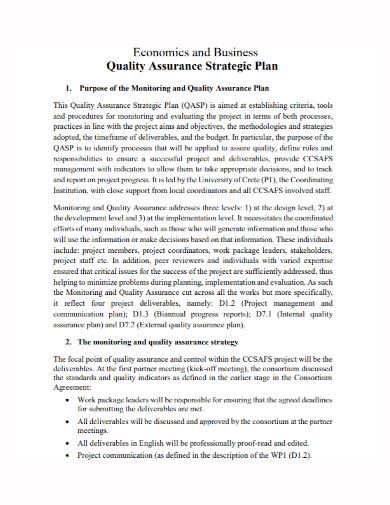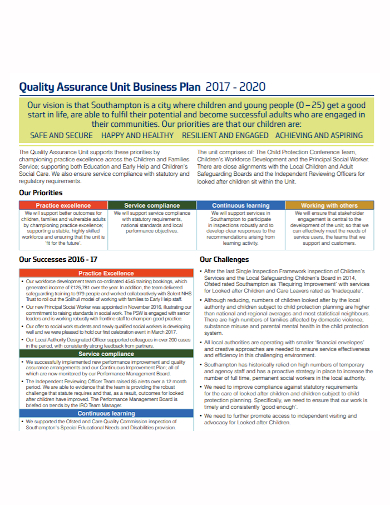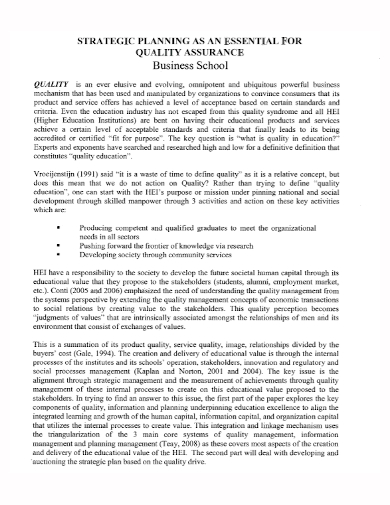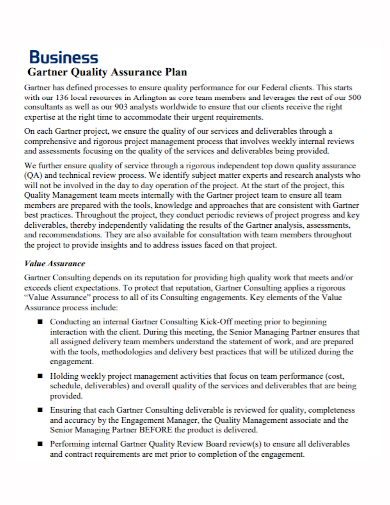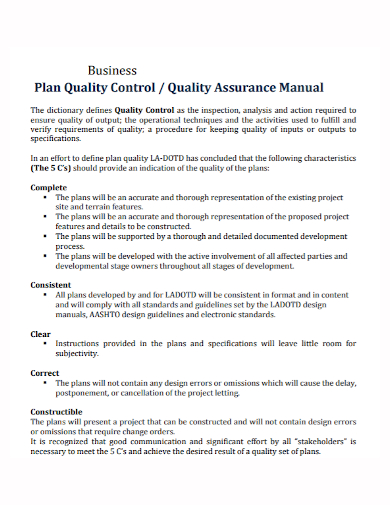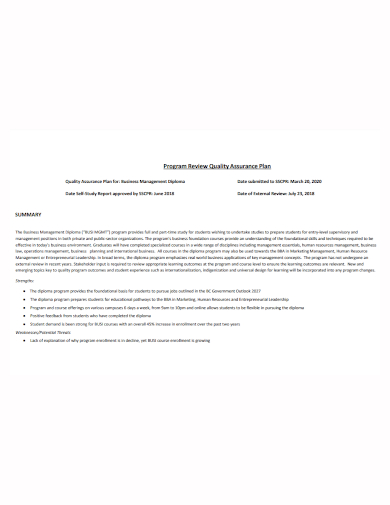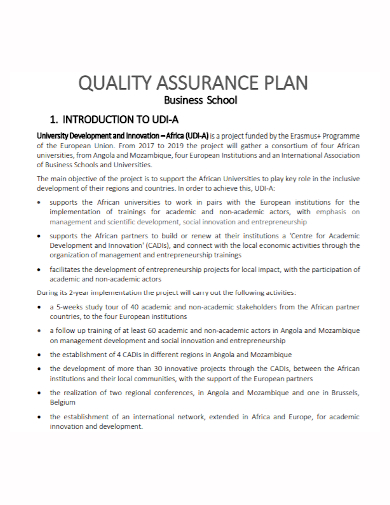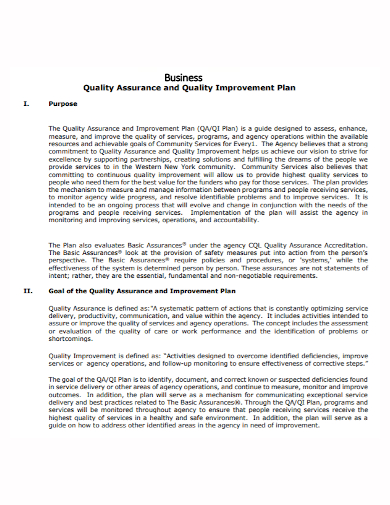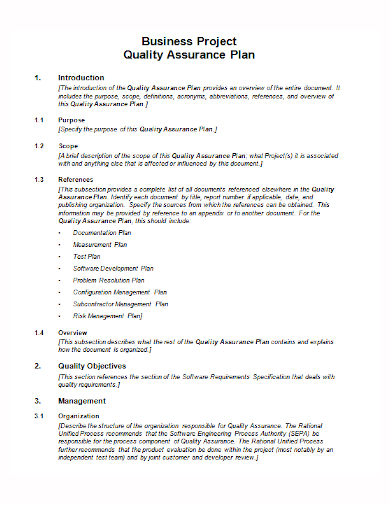Quality assurance (QA) seeks to maintain a product’s or service’s quality at a certain level, focusing on each stage of delivery or production to ensure no problems arise. Maintaining a high degree of quality is critical to a company’s long-term success. A good quality assurance program will help firms achieve their objectives by identifying the areas where they excel and where they need to improve. Following a strong quality assurance plan lowers the likelihood of costly errors and lowers risk. It is important to highlight that quality assurance is not the same as quality control (QC). QA is concerned with defect avoidance, whereas QC is concerned with finding product flaws. Though there may be some overlap between the two, a QA plan differs from a QC strategy.
A quality assurance business plan is a document created by the project team to ensure the highest quality of final products. A quality assurance plan is a series of documented activities that a firm uses to guarantee that consumers are pleased with the goods or services it offers. Plan, Do, Check, and Act are the four steps in the quality assurance process. This essay will concentrate on the components of a quality assurance plan. The quality assurance plan should include objectives, roles, and duties, as well as task and schedule definitions and coordination with other plans.
10+ Quality Assurance Business Plan Samples
1. Quality Assurance Business Plan Template
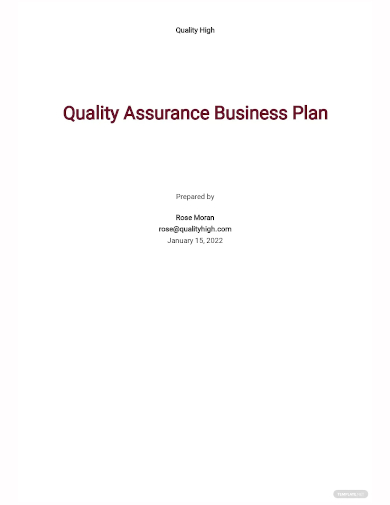
2. Quality Assurance Economic Business Plan
3. Quality Assurance Unit Business Plan
4. School Quality Assurance Business Plan
5. Quality Assurance Business Plan
6. Sample Quality Assurance Business Plan
7. Quality Control Assurance Business Plan
8. Business Management Quality Assurance Plan
9. Quality Assurance Development Business Plan
10. Quality Assurance Improvement Business Plan
11. Project Quality Assurance Business Plan
Creating a Quality Assurance Business Plan
- Define your quality objectives – Defining your goals is the first stage in quality control planning. The SMART goal setting formula is a popular tool in this process. Specific, Measurable, Appropriate, Realistic, and Timely goals should be set. They must be specific, measurable, and realistically achievable in a reasonable amount of time. Your quality objectives must also be in line with what your customers expect. If your product is of poor quality, it will fail both the client and the firm. You should also be sure to follow any government restrictions that may be applicable to the project.
- Roles and responsibilities – There are several options available when you decide to move forward with a quality strategy. Small businesses may need to go outside the organization or assign additional roles to current employees, whereas large businesses may have an entire department dedicated to quality assurance. Staff training is critical, as is providing them with positions that match their skill set. You’ll need a team in place that can spot and fix problems early in the product development process. This avoids mistakes and ensures that the company meets the expectations of its customers.
- Quality assurance plan implementation – It’s time to put your new quality control methods in place after the plan is complete. Ensure that all employees have been taught and are familiar with the plan’s contents. It’s also critical that your team has the tools and resources it requires to achieve its objectives. The strategy should be concise and obvious in how it supports the company’s objective, so there is no doubt that everyone understands it and that each stage of the process is carried out correctly. Confirm with HR and production that the QA plan also complies with risk management and documentation criteria.
- Examination of the results – Consider the Quality Assurance plan a live document that may change and evolve as the team sees appropriate once it is in place. While the QA plan’s main goal should be kept in mind, they are also utilized to ensure that the team’s objectives are met. If not, what are the reasons behind this and how can new policies and procedures help? Listen to your teammates, coworkers, and customers to ensure that you’re meeting everyone’s reasonable expectations.
- Make necessary adjustments – Adjust as needed after listening to feedback and reviewing the initial aims. While many people recommend doing a plan audit every two to three months, it can be done sooner if necessary. If a mistake is discovered or issues arise, implementing changes as quickly as possible is beneficial not only in reaching the company’s aim but also in saving or growing sales by introducing a better product or service.
- Keep your team in the loop – Employees want to know if what they’re doing is effective. Let them know if the QA approach has helped the company. Positive or constructive feedback helps to build a stronger team and shows employees that they are contributing to the company’s success. The fact that you are empowering employees to make a difference motivates them to keep doing a good job and provides valuable input into the QA process. As a result, have employees stick to the plan, provide both positive and negative feedback, and listen so that changes may be implemented.
FAQs
What are quality objectives?
You must ensure that the project’s objectives have been specified, regardless of the system you employ. For setting quality objectives, Six Sigma employs a specified algorithm. Identifying the needs of the consumers is a part of developing the quality plan project’s objectives. Make certain that your goals are well-written and specific.
What is included in the outline of a quality business plan?
It includes the general information, schedule of tasks and responsibilities, system documentation, review and audit, testing, problem reporting and corrective action, tools, project controls, training, and risk management.
If you want to see more samples and formats, check out some quality assurance business plan samples and templates provided in the article for your reference.
Related Posts
FREE 10+ Quality Action Plan Samples
FREE 10+ Clinical Quality Management Plan Samples
FREE 10+ Contractor Safety Plan Samples
FREE 10+ Performance Action Plan Samples
FREE 9+ Construction Implementation Plan Samples
FREE 7+ Health and Safety Coordination Plan Samples
FREE 4+ HACCP Principles & Plans Samples
How to Run a Successful B2B Marketing Campaign?
FREE 31+ Sample Business Plan
FREE 20+ Work Plan Templates
FREE 11+ Employee Work Plan Templates
FREE 10+ Consultant Job Description Samples
FREE 10+ Monthly Quality Report Samples
FREE 9+ Project Execution Plan Templates
Things Every Manager Should Know about Marketing

